How to Train Cats to Stay Off Counters
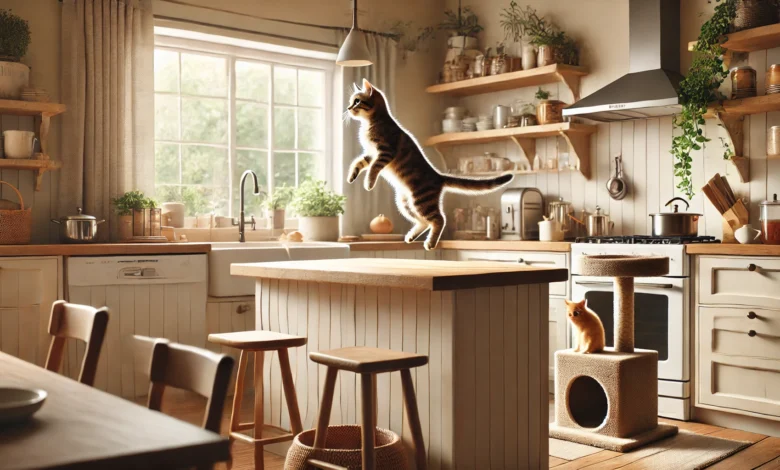
Curiosity, flexibility, and higher grounds are what cats love.
And if you are a cat owner, high above on your kitchen counter, you may have often found your feline friend perched and peering around or searching for something edible.
Although this is not a problem per se, restlessness could soon set in with the breaking of dishes, contamination of food, or even safety risks.
Knowing how to keep your cat off the counters is essential not only to make your home clean and safe but also to establish limitations with your feline friend.
In this post, we will investigate the reasons behind this behavior and ways to train your cat to stay off counters, so you can keep your mind at ease and your cat happy.
Understanding why cats love counters will help you understand their mindset and prepare an effective training or behavior modification plan.
Table of Contents
Why Do Cats Love Climbing Counters?
Is your cat drawn to the countertops when, in fact, you have asked them to stay off?
Well, it’s more than just a mischievous streak; cats possess natural instincts and behaviors that can drive them to seek out high places, such as your kitchen counter.
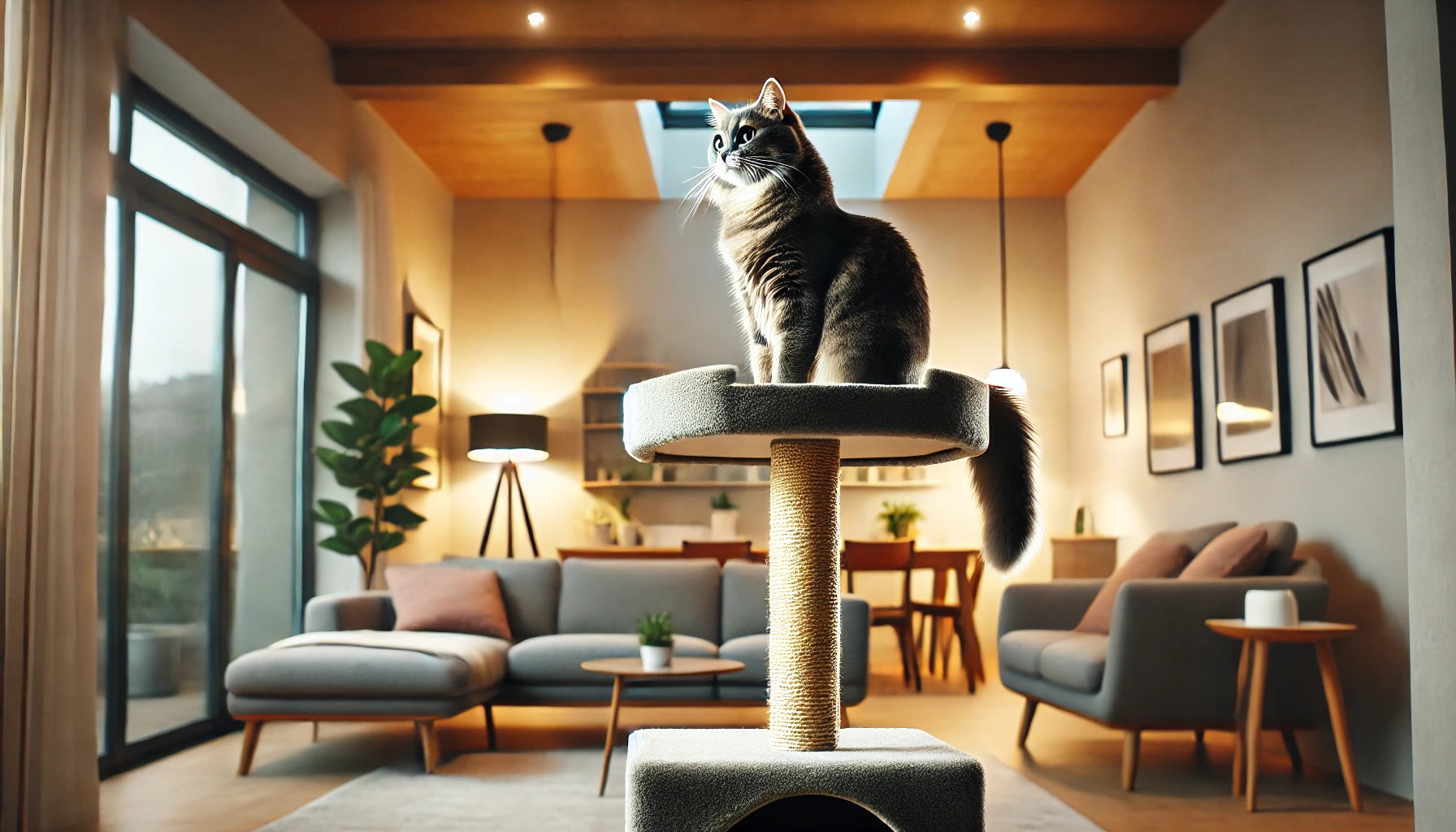
Natural Instincts: Cats and Elevated Spaces
Cats like to climb.
In their natural environment, cats elevate themselves for various reasons, such as assessing the surroundings for threats or prey.
This instinct is still strong in domesticated cats.
Elevation makes them feel safe, gives them a vantage point, and allows them to observe the environment without feeling vulnerable.
This is exactly the behavior your cat is following when they jump onto the counter.

Curiosity and Exploration
Cats are some of the most curious creatures and generally enjoy exploring new environments.
The kitchen counter is filled with interesting sights, smells, and objects.
From the aroma of food to shiny appliances, everything on your counter is a new adventure your cat might want to explore.
So, it’s no surprise they get attracted and climb up to take a look.
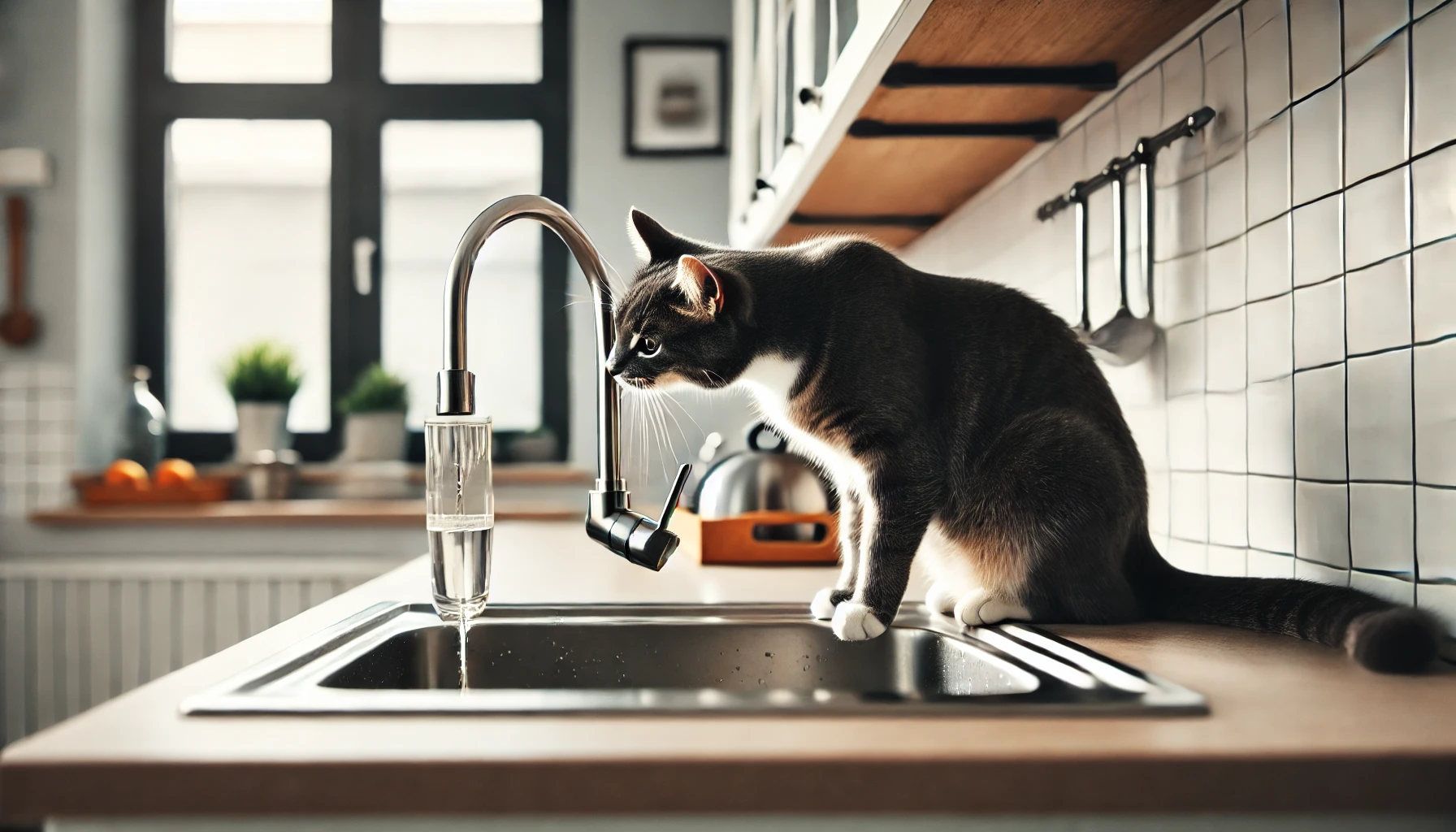
Food and Water Sources
One of the most obvious reasons cats jump onto counters is in search of food or water.
From the tempting smell of a meal left out to the water running from the sink, your cat is simply acting on its instinct to find food and water.
This happens very often when food is left uncovered or when cats learn they may find treats by climbing up.

Attention-Seeking Behavior
Some cats jump onto counters simply because it gets your attention.
If they learn you’ll react—whether to scold them or to pick them up and put them on the floor—they may do it again because they’re trying to interact with you.
Cats thrive on attention, and even a negative reaction can reinforce the behavior if they’re seeking an exchange of any kind.
By understanding these key motivations, you can begin to effectively retrain your cat to stay off counters.
The next step is exploring specific training techniques that work with your cat’s nature, rather than against it.
Understanding why cats are drawn to elevated spaces is key to modifying this behavior.
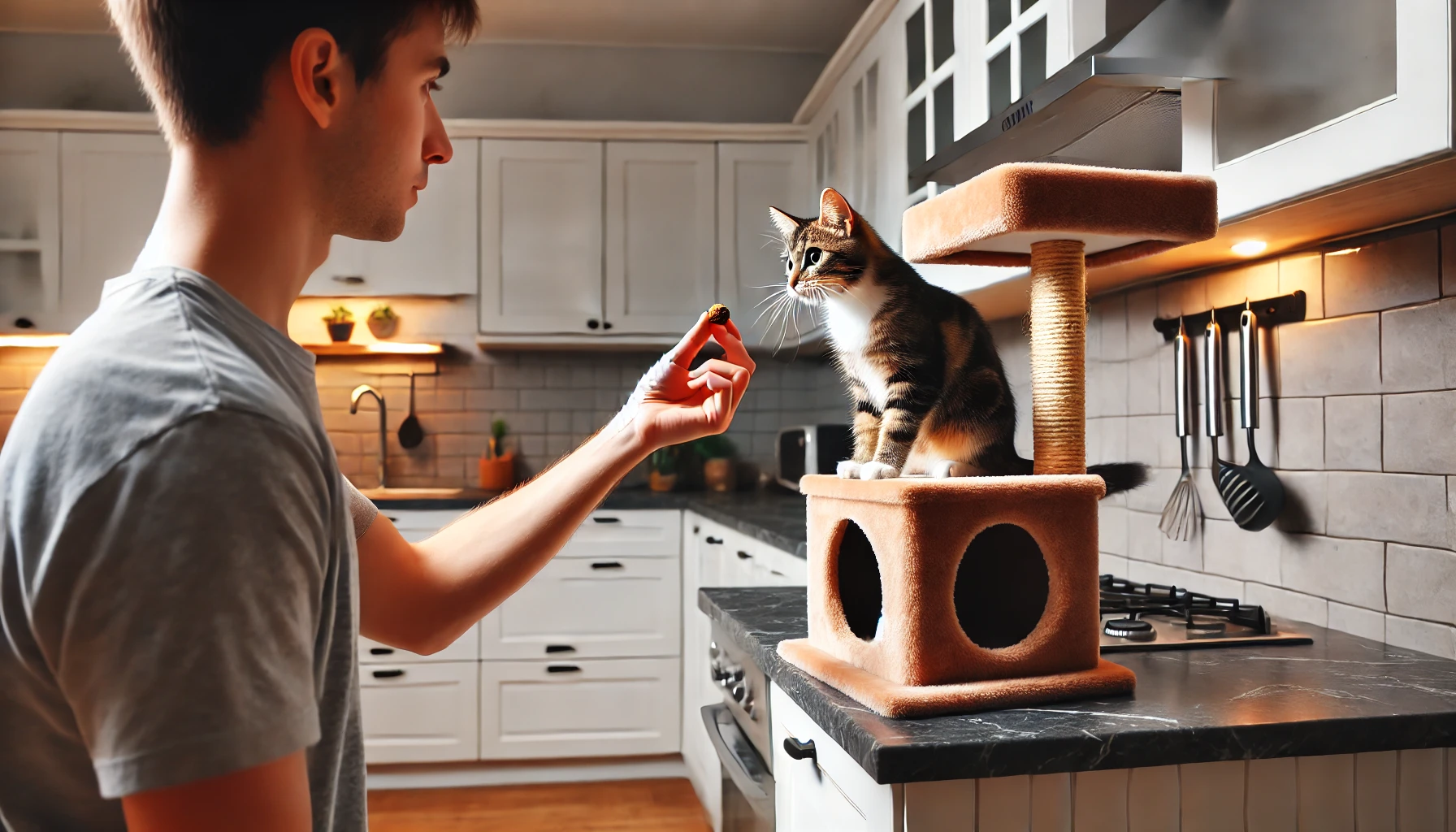
Effective Training Techniques to Keep Cats Off Counters
Training a cat to stay off counters requires time, coupled with a high level of understanding and patience to practice behavior modification.
Since cats are independent and instinctual, you cannot force them to change their behavior, but you can work in harmony with them.
Luckily, there are several ways through which you can train your cat using effective techniques.
These strategies will help teach your cat to stay off counters without hindering their natural instincts.
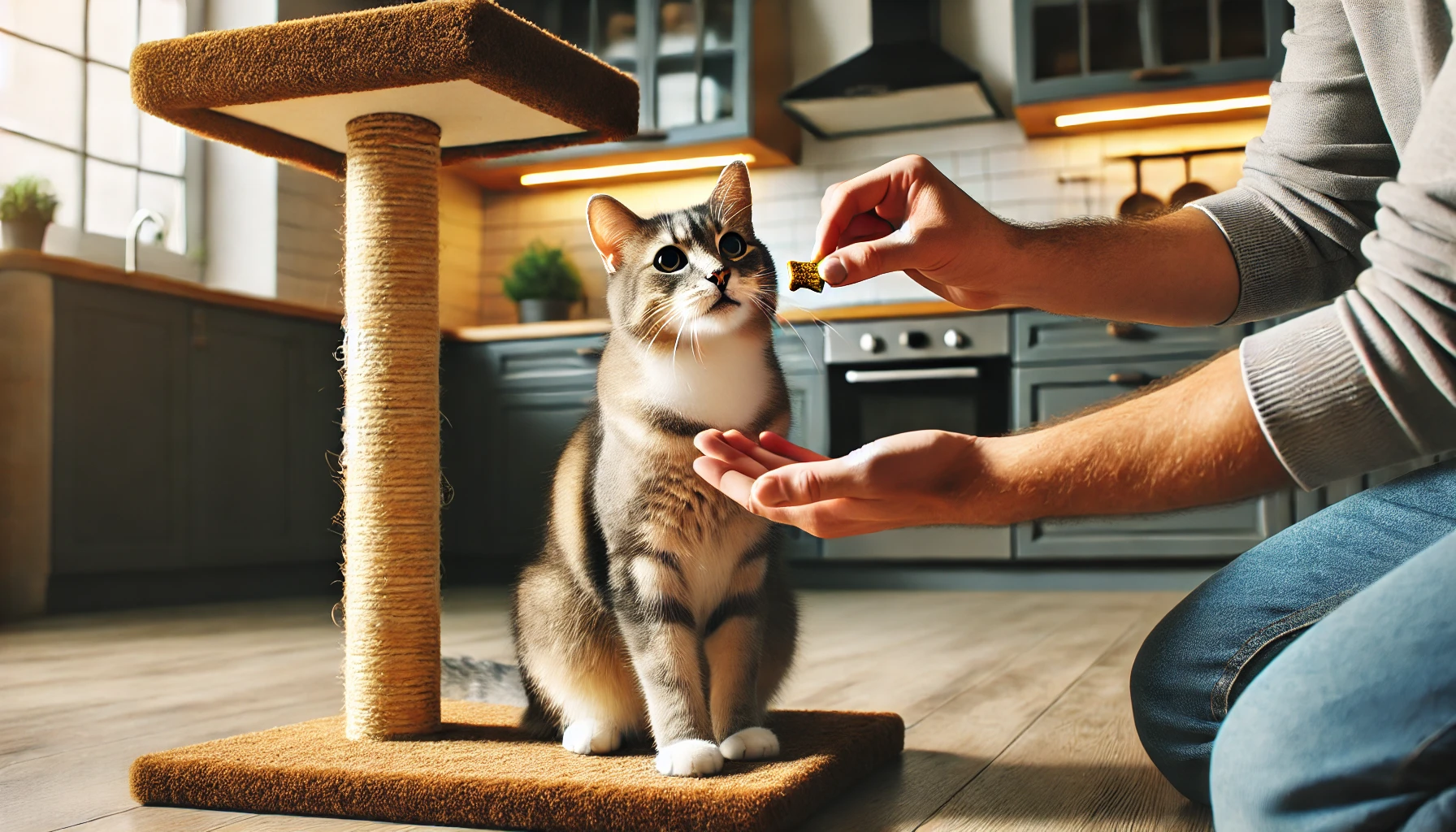
Positive Reinforcement: Rewarding Good Behavior
One of the best ways to train a cat includes positive reinforcement.
This means rewarding your cat for behaving as desired.
Every time your cat chooses to stay off the counters or uses an appropriate alternative, such as a cat tree, make sure to reward them with treats, praise, or playtime.
This positive reinforcement helps embed the desired behavior into their psyche, encouraging them to repeat it.
Consistency is key with rewards, so they can clearly understand what they are being rewarded for.
- Reward your cat with treats when they use a designated area like a cat tree.
- Verbal praise or physical attention reinforces good behavior and helps keep your cat off the counters.
- Use toys to distract your cat from the counters and direct them toward the right places.
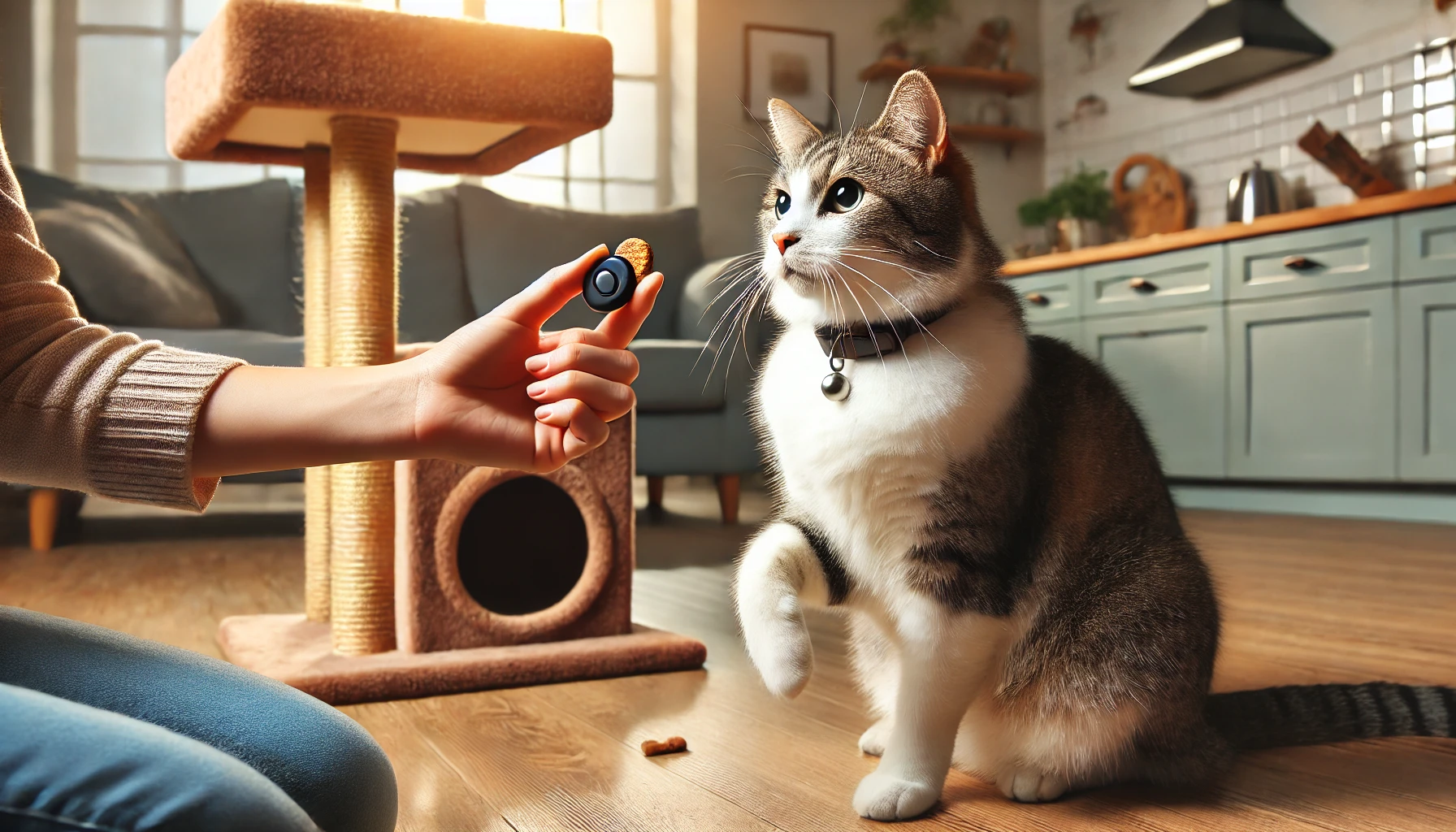
Clicker Training for Cats
Clicker training, a popular technique for dogs, works equally well for cats.
The idea is to use a clicking sound to signal that the cat is doing something right.
Start by pairing the clicker with a treat, so the cat associates the sound with a reward.
Once they understand the connection, use the clicker when they stay off the counter or jump to their cat tree.
- Click when your cat jumps onto their cat tree or stays off the counter.
- Immediately give a treat after clicking to reinforce the behavior.
- Repeat this process to build a strong association between the click and the desired behavior.

The Magic of Consistency
Consistency is essential when training cats.
If you enforce the rules inconsistently, your cat will receive mixed messages and won’t understand what behavior is expected.
Make sure everyone in your household follows the same rules without deviation.
For example, if one person rewards the cat for staying off the counter while another lets them roam freely, the cat will become confused.
Stick to a schedule and remember that training takes time.
The more consistent you are with your methods, the faster your cat will learn to stay off counters.
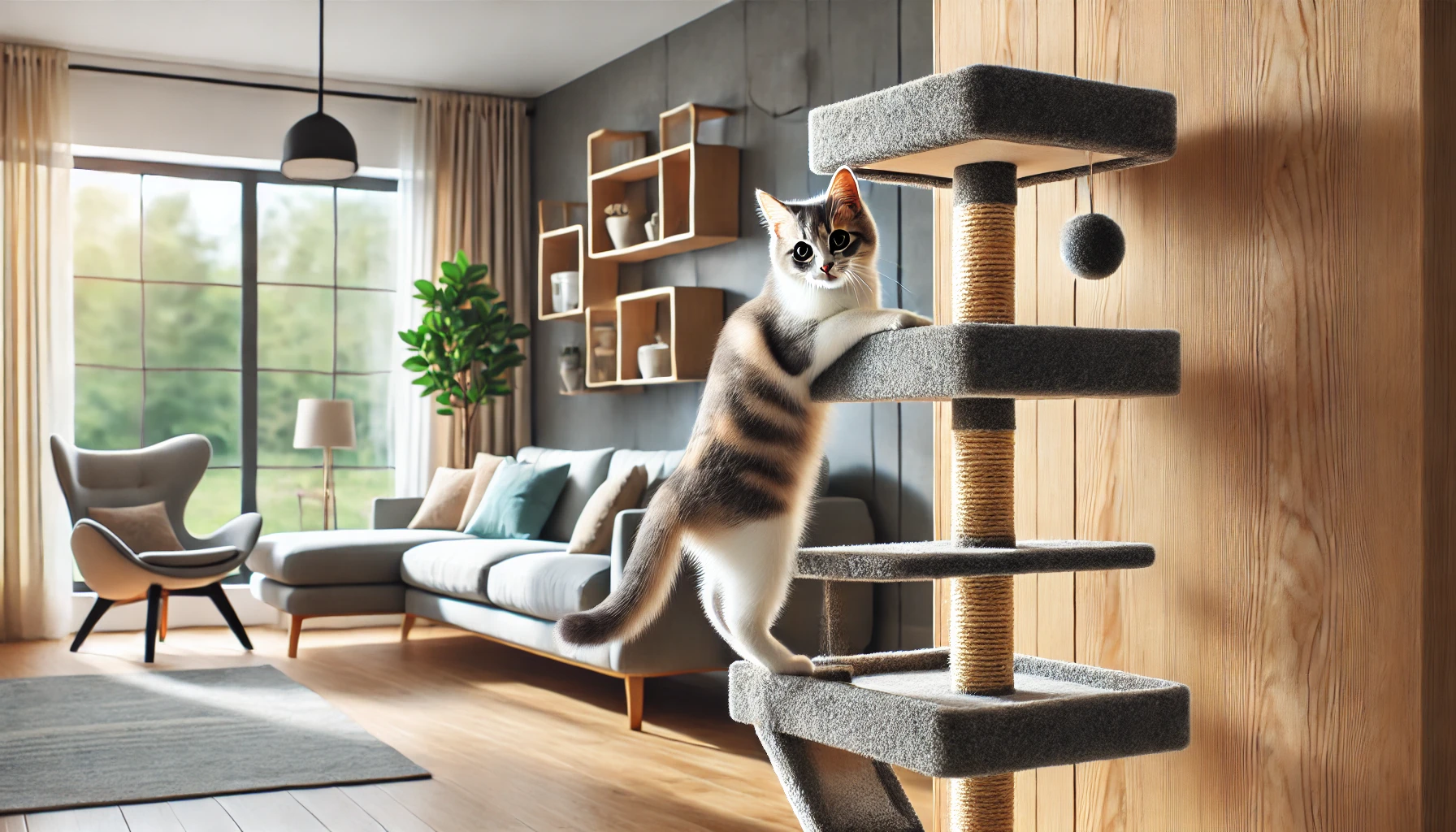
Redirecting Attention with Cat Trees or Shelves
Cats love height, so instead of trying to keep them off the counters, provide an alternative.
Cat trees, shelves, or other raised furniture give them a special place to climb and observe without getting into trouble.
Place these alternatives near the areas they like to jump, such as the kitchen, to make them more appealing.
- Place a cat tree in your kitchen to redirect your cat’s climbing instincts.
- Install cat shelves near windows to offer your cat another viewpoint.
- Reward your cat for using these spaces instead of the counters.
By combining these strategies, you can effectively train your cat to stay off counters while giving them appropriate outlets for climbing and exploration.
Remember, cats thrive on routine, so if you stick to training and providing alternatives consistently, the changes will be long-lasting.
Consistent training and positive reinforcement can lead to long-term success in keeping cats off counters.
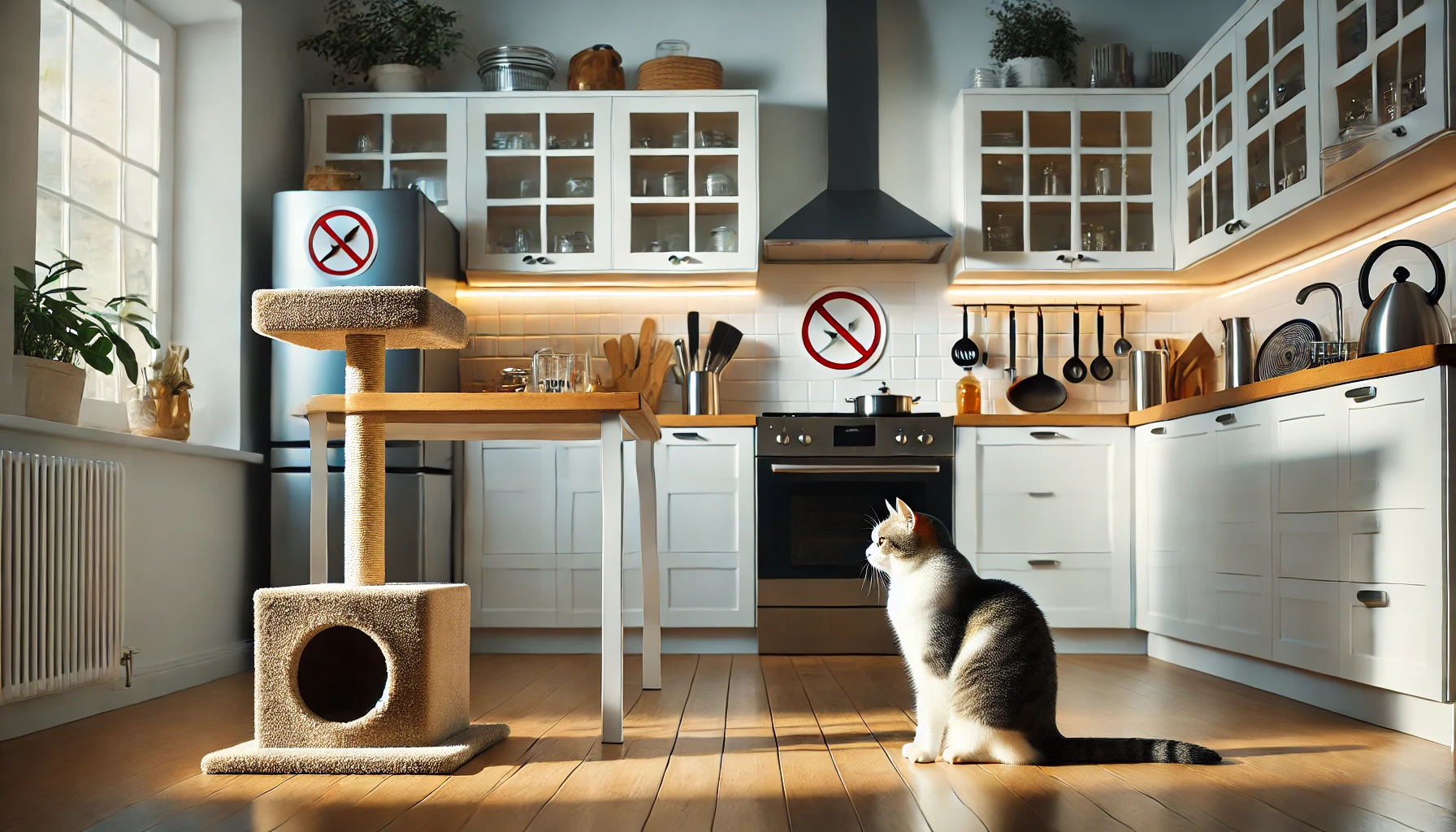
Counter-Free Areas: Preventive Measures
Keeping your cat off the counters is about more than just training; it’s about making the counters less inviting for your feline friend.
By setting up counter-free zones and making a few changes to your home, you can effectively deter your cat from attempting to jump onto the counters in the first place.
Let’s dive into some effective ways to prevent your cat from jumping onto counters and help them stay off.

Creating Cat-Friendly Alternatives
Cats have a natural instinct to seek out high places, so providing alternatives to countertops is an effective way to keep them satisfied without allowing them to bother you in the kitchen.
You can introduce cat trees, shelves, or window perches in your home.
The key is to make these alternatives more appealing than the kitchen counters by placing them in strategic locations where your cat can climb, scratch, and enjoy a good view.
- Place cat trees in front of windows so that your cat has something interesting to look at.
- Install wall shelves or ledges for your cat to climb onto and enjoy elevated spots.
- Make these options more attractive than counters by placing treats or toys on them.
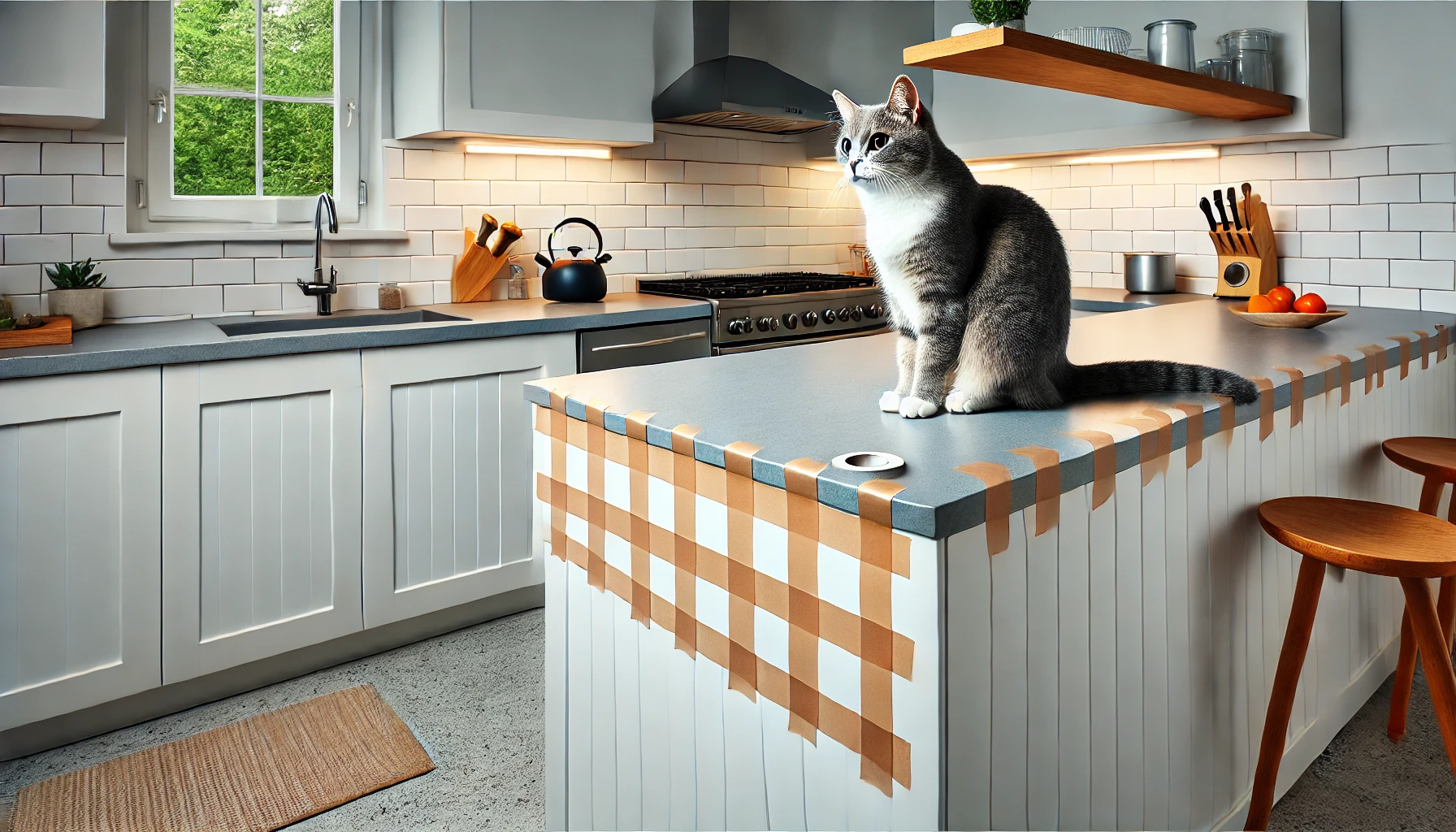
Using Deterrents Like Double-Sided Tape or Aluminum Foil
Cats dislike certain tactile sensations under their paws, which you can use to your advantage.
Placing double-sided tape, aluminum foil, or other harmless but uncomfortable materials on your counters can deter your cat from climbing on them.
The unpleasant sensation produced by these textures makes countertops less appealing.
- Place double-sided tape along the edges of the counters to prevent your cat from jumping up.
- Use aluminum foil on countertops; most cats do not like the sound or feel of foil.
- Try using upside-down plastic carpet runners with the spiked side up for an uncomfortable surface.
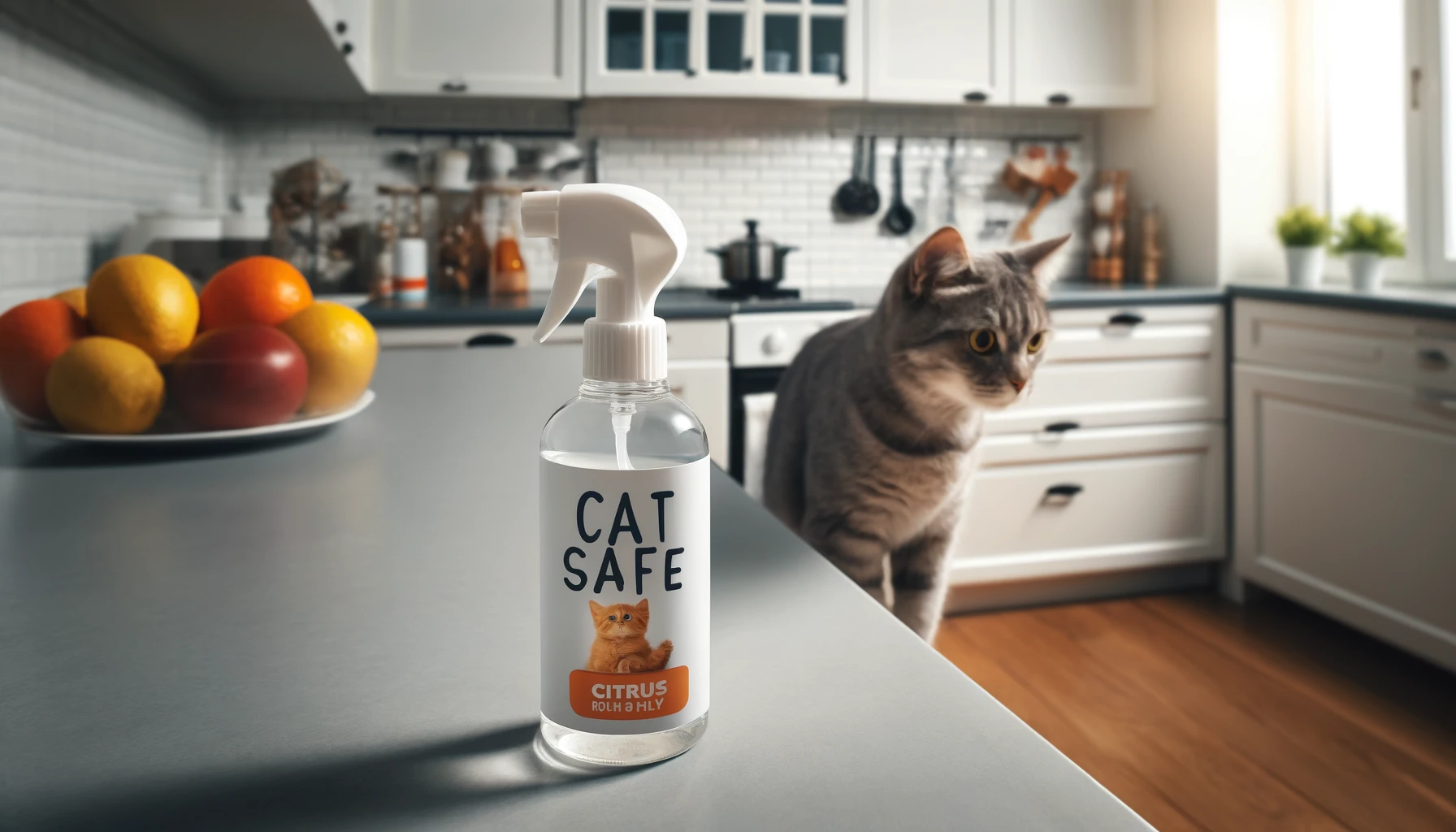
Training Cats with Odors and Textures They Dislike
Cats have a very sensitive sense of smell, and there are certain scents they find unpleasant, particularly citrus or vinegar.
You can use these odors to keep your cat off counters by spraying them in areas where your cat is tempted to climb.
There are also commercial sprays available that are safe for cats but can be used to deter them from jumping onto counters.
- Spray a citrus-scented spray along the edges of your counters to help deter your cat.
- Use vinegar or other cat-safe deterrents on surfaces your cat frequently jumps onto.
- Experiment with different scents to see what works best for your cat.

Keeping Food and Smells Off Counters
Food is likely one of the major reasons your cat is attracted to counters.
Keeping your counters clear of food and tempting smells will make them less appealing to your cat.
Store food in containers or cupboards, and make sure to wipe down counters to remove any food residue that could catch your cat’s attention.
- Store food in airtight containers or put it away immediately after cooking.
- Clean countertops regularly to remove food particles and tempting odors.
- Cover or place lids on any food left out to eliminate temptation for your cat.
By implementing these preventive measures, you can create an environment where the counters are less attractive, encouraging your cat to stay off and use appropriate spaces instead.
Preventive measures like deterrents and environment modifications can effectively keep cats off counters.

Common Mistakes to Avoid While Training Cats
Training your cat to stay off the counters is a considerate and necessary task, but even with the best of intentions, it’s easy to make mistakes that might hinder progress.
By understanding and avoiding these common mistakes, you will ensure your training is effective and that your cat responds well to behavior modifications.
Below are some of the most frequent mistakes made by cat owners when trying to train their cats to stay off counters.

Punishing Your Cat: Why It Doesn’t Work
One of the worst things you can do is punish your cat for jumping onto counters.
Cats do not respond well to punishment; they may fear you and not understand why their behavior was undesirable.
Instead of learning what not to do, your cat might associate the punishment with your presence, which can damage the trust between you and your pet.
Positive reinforcement works much better than punishment in training cats.
Instead of yelling or using harsh methods, reward your cat when they exhibit good behavior.
Eventually, they will learn to avoid counters and develop better manners this way.

Inconsistent Training Methods
Consistency is key when training a cat.
One common mistake is inconsistency with the rules, which gives your cat mixed messages.
Sometimes allowing them on the counter and at other times scolding them creates confusion about what is acceptable.
To successfully train your cat to stay off counters, make sure that everyone in the house follows the same rules.
- Ensure that all family members are on the same page with the training approach.
- Do not allow your cat to stay on the counter even for a short time out of convenience.
- Reward good behavior consistently to avoid confusing your cat.

Overlooking the Root Cause of the Behavior
Many cat owners focus on keeping their cats off counters without considering the reasons behind the behavior.
Cats jump onto counters for a variety of reasons—curiosity, exploration, or access to food and water.
If these needs aren’t met, your cat may continue jumping on counters.
By providing alternatives like cat trees or shelves and storing food properly, you remove the motivation for your cat to climb onto counters.
Understanding why your cat is drawn to counters will help you redirect their behavior more effectively, ensuring long-term success in keeping them off.
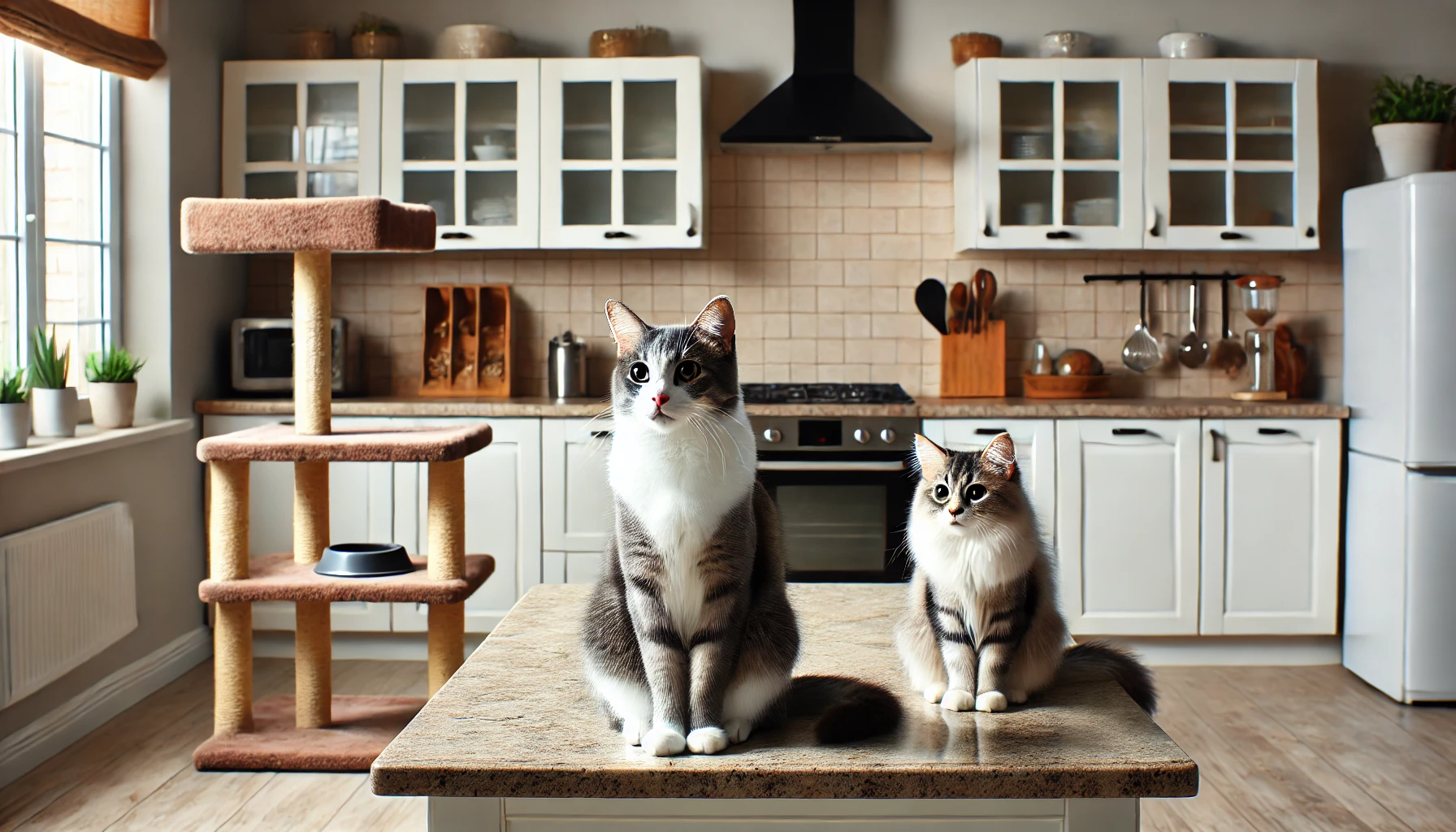
Ignoring Environmental Enrichment
Cats are intelligent animals and need stimulation.
If their environment is boring, they will find ways to entertain themselves, which often includes jumping onto counters.
Providing enough environmental enrichment can help keep your cat occupied and less interested in countertops.
- Offer a variety of toys, especially problem-solving or interactive ones.
- Use puzzle feeders to make mealtime more engaging for your cat.
- Rotate toys regularly to keep your cat interested and entertained.
By avoiding these common mistakes, you increase your chances of successfully training your cat to stay off counters, creating a more harmonious environment for both you and your feline friend.
Avoid punishment, inconsistent training, and neglecting the root causes of counter-jumping.
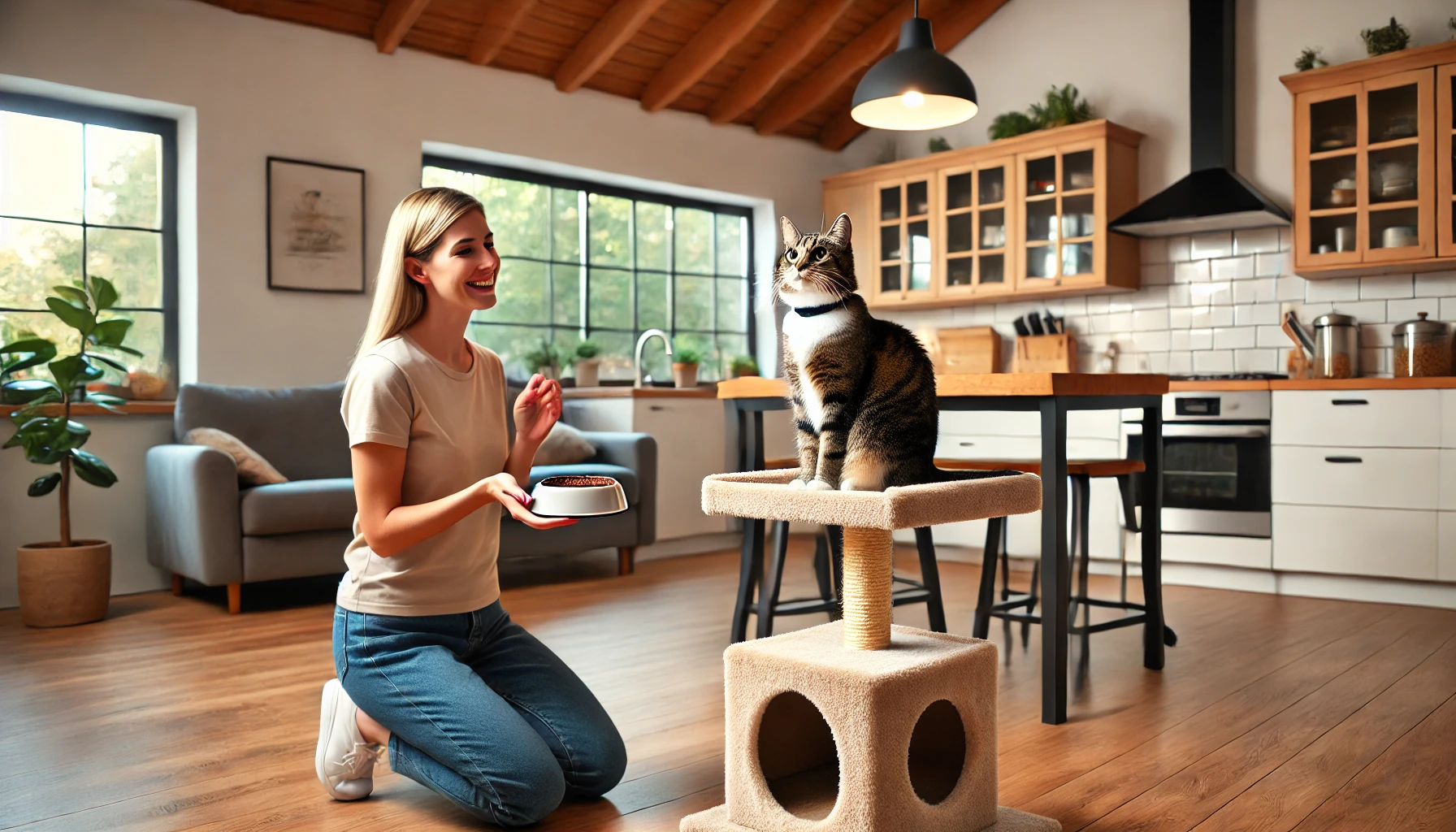
Long-Term Success: How to Keep Your Cat Off the Counters
Long-term maintenance is crucial once you have successfully trained your cat to stay off counters.
Cats are creatures of habit, and it takes continued effort to ensure they follow the new rules.
Fortunately, by reinforcing positive behavior and adjusting the environment to meet your cat’s needs, you can keep them off counters for the long term.
Here are some tips to help ensure your cat stays off counters permanently.

Reinforcing Positive Behavior Over Time
Even after your cat has learned to stay off counters, it’s essential to continue reinforcing this good behavior.
Occasional rewards remind your cat of the behavior you want them to maintain.
Continue to offer praise, treats, or playtime whenever they choose their climbing spots instead of jumping on counters.
Positive reinforcement shouldn’t end after the initial training phase; it should be a consistent part of your relationship with your cat.
- Reinforce positive behavior by giving treats occasionally when they stay off the counters.
- Reward and give attention when they use the cat tree or other approved surfaces.
- Consistently reinforce good behavior with positive reinforcement.
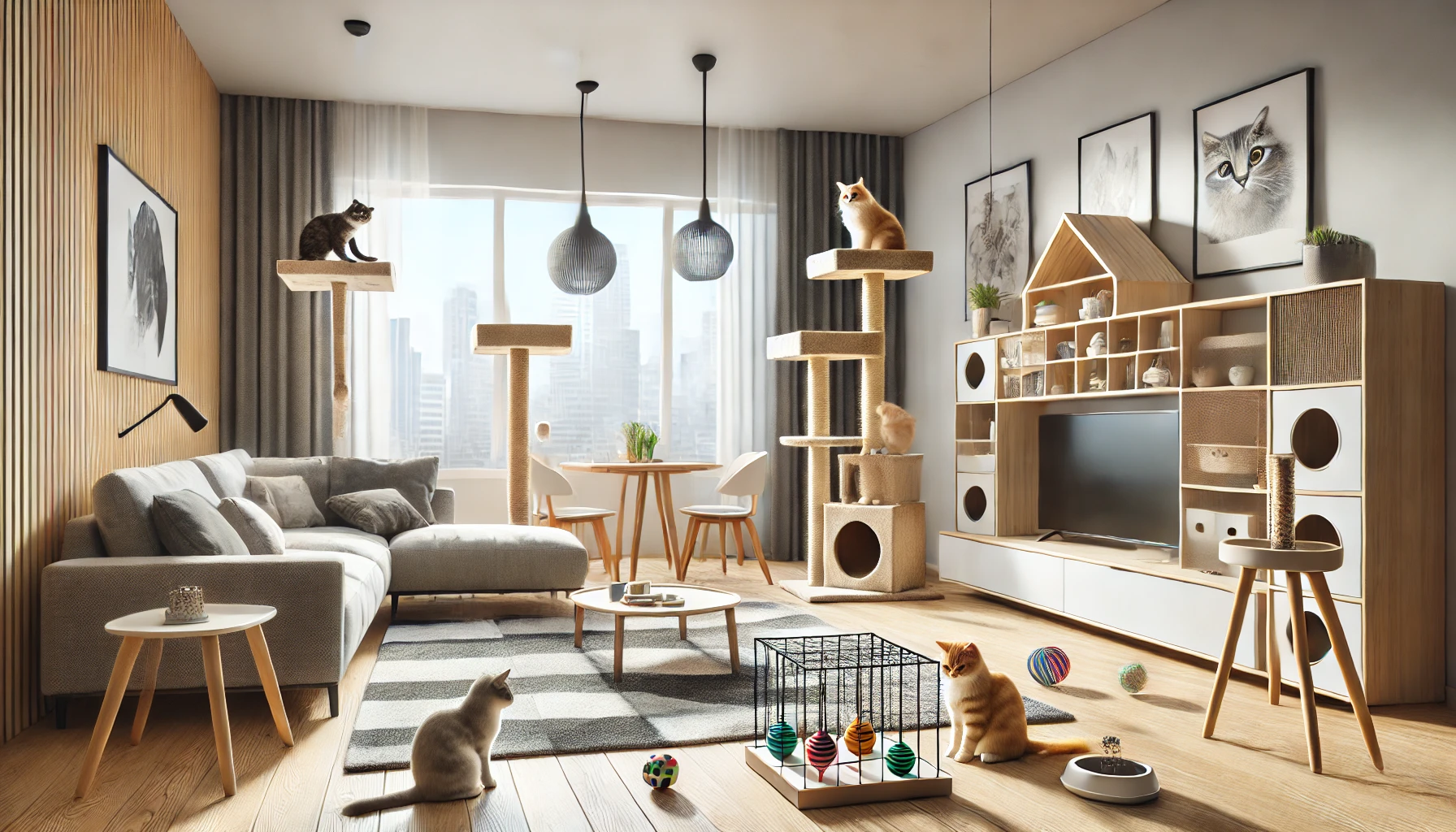
Changing the Environment to Meet Your Cat’s Needs
As your cat ages and their needs change, you may need to adjust their environment to keep them satisfied.
This could mean upgrading their cat tree, adding new toys, or providing more climbing areas to stimulate them.
Ensure your home still caters to your cat’s need to explore and play.
This way, they won’t be tempted to revert back to jumping on counters.
- Replace or update old cat trees with newer, more stimulating ones.
- Install new shelves or window perches to offer variety in climbing opportunities.
- Provide new toys or interactive items to prevent boredom.

Using Interactive Toys and Activities
Cats need both mental and physical stimulation, and interactive toys can help prevent boredom.
Puzzle feeders, treat-dispensing toys, and laser pointers are great ways to keep your cat engaged and away from counters.
Regular play sessions help satisfy their curiosity and energy, reducing the likelihood of undesirable behaviors returning.
- Use food puzzle feeders at mealtimes to make eating more challenging and fun.
- Incorporate laser pointers and interactive toys into their playtime.
- Schedule regular play sessions to provide enough physical and mental stimulation.

Monitoring Progress and Making Adjustments
Keep an eye on your cat’s behavior and be prepared to make adjustments as needed.
If you notice your cat returning to old habits or jumping back onto counters, revisit your training methods and evaluate their environment.
Ensure they still have sufficient alternatives for climbing and continue to reinforce positive behavior with rewards.
Small adjustments can make a big difference in long-term success.
- Monitor your cat’s behavior regularly to ensure they stay off counters.
- If old habits return, go back to your training and reinforcement methods.
- Keep the environment engaging and stimulating to meet your cat’s needs.
By following these steps, you can ensure your cat stays off counters and is happy with appropriate spaces to climb.
Long-term success depends on ongoing reinforcement and environmental enrichment, helping both you and your cat live harmoniously together.
Maintaining long-term success requires reinforcing positive behavior and regularly adjusting the environment.
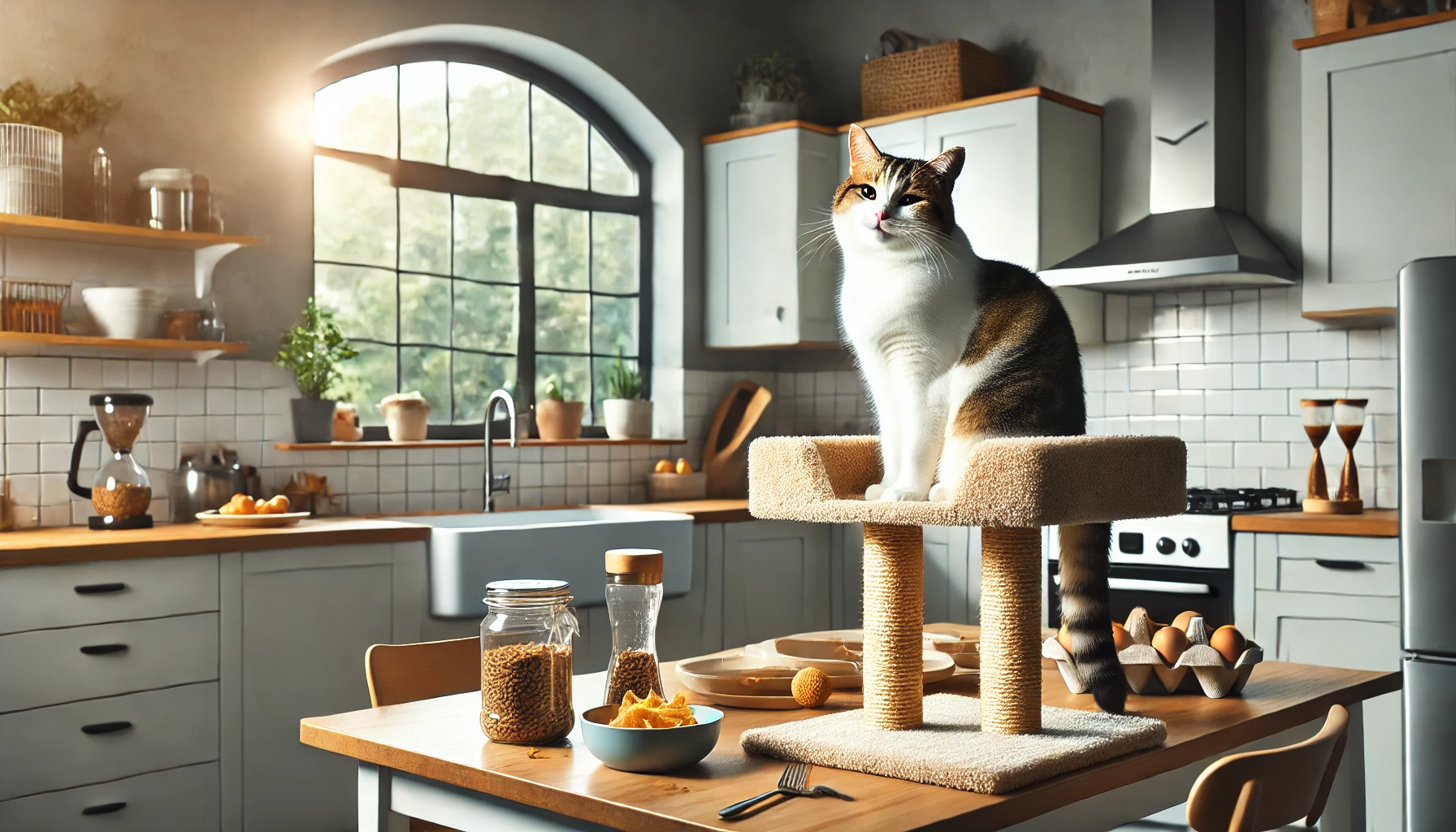
Conclusion: How to Keep Your Cat Off Counters for Good
The formula for keeping your cat off counters involves a combination of techniques: patience, consistency, and understanding your cat’s natural instincts.
By creating an environment that satisfies your cat’s needs and keeps them off counters, you can achieve long-term success.
This article has discussed the deeper motivations behind a cat’s attraction to high places and outlined effective training methods that work with, not against, their nature.
By employing the appropriate methods, you can ensure your cat stays off counters, contributing to a cleaner, more hygienic, and safer home.
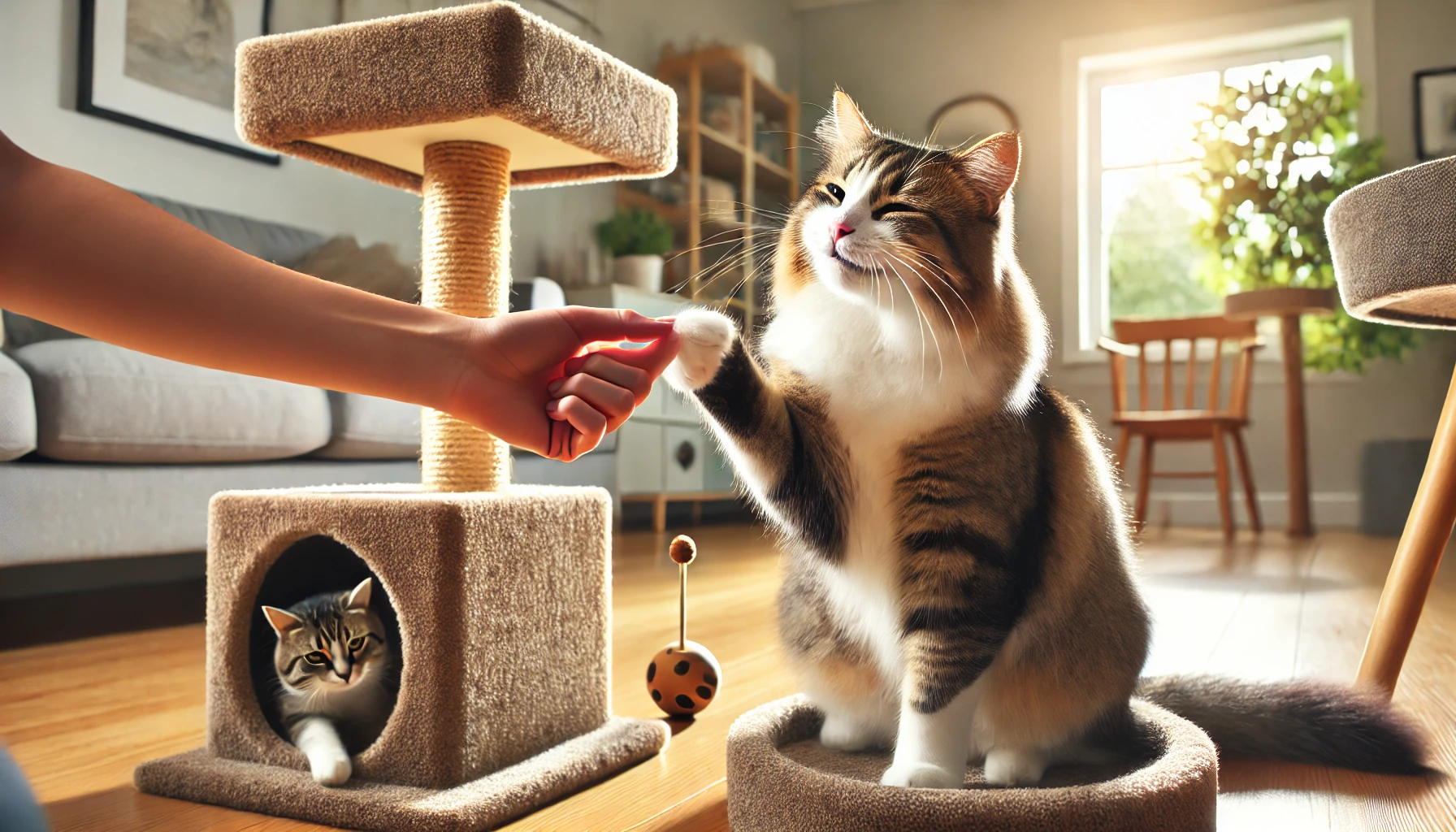
Long-Term Success Key Points
To successfully keep your cat off counters, remember to:
- Provide alternatives like cat trees, shelves, or perches to fulfill their need for climbing and exploring.
- Use positive reinforcement consistently, rewarding good behavior to set patterns for desired actions over time.
- Avoid common mistakes like punishment, inconsistent training methods, and neglecting your cat’s natural instincts.
- Continue enriching your cat’s environment with engaging toys, interactive play, and stimulating activities to prevent boredom.
- Monitor and make adjustments to the environment as needed to ensure your cat’s happiness and to keep them off counters.

Creating a Harmonious Environment
Long-term success depends on creating an environment where your cat feels fulfilled and has no need to jump onto counters.
By understanding your cat’s need for height, exploration, and stimulation, you can design a home that keeps your cat engaged and satisfied.
Providing cat-friendly alternatives like high perches and stimulating toys will make your cat less tempted to return to countertops.
It’s all about finding a balance that works for both you and your cat—allowing them their own space while maintaining the cleanliness and safety of your kitchen.
Achieving this balance requires ongoing commitment, but the rewards are well worth it.
With continued reinforcement and thoughtful adjustments to your cat’s environment, you can enjoy a counter-free home and a happier, healthier relationship with your feline friend.

Consistency Is Key
Consistency is the most important factor when training your cat to stay off counters.
Cats thrive on routine, and by maintaining consistent rules and reinforcement, you’ll help them understand what’s expected.
Whether it’s through rewarding good behavior or providing new climbing opportunities, consistency will keep your cat on track and ensure they remain counter-free over time.
In summary, training your cat to stay off counters requires time, persistence, and patience.
If you follow the steps outlined in this article, you can create a home that works for both you and your cat—setting clear boundaries while keeping your pet happy, active, and counter-free.
Consistency, patience, and understanding are the pillars of long-term success in keeping cats off counters.

FAQs: How to Keep Your Cat Off the Counters
Following are some of the most common questions regarding training your cat to stay off the counters, along with helpful answers.
Why does my cat jump onto the counters?
Cats have innate curiosity and enjoy climbing high to investigate their surroundings, feel secure, or hunt for food.
Their climbing instinct drives them onto counters to observe their environment.
How can I train my cat to stay off counters?
Use positive reinforcement by rewarding your cat for staying off the counters.
Provide alternatives, like cat trees and shelves, to satisfy their climbing instinct without resorting to punishment.
Does punishment work with cats?
Punishment does not work and can damage your relationship with your cat.
Instead, use positive reinforcement and redirection to keep them off the counters effectively.
What alternatives can I give my cat?
Consider offering cat trees, shelves, and window perches as alternatives.
These provide your cat with opportunities to climb and explore without jumping on counters.
How often should I reward my cat?
Reward your cat consistently for staying off the counters.
Frequent rewards reinforce good behavior, encouraging them to continue using approved climbing spaces.
Can my cat learn to stay off counters permanently?
Yes, with consistent training, positive reinforcement, and environmental enrichment, your cat can remain off counters permanently while living a fulfilled and happy life.
What can I use to distract my cat?
Interactive toys, puzzle feeders, and stimulating play sessions can distract your cat from counters.
These activities satisfy your cat’s curiosity and reduce the tendency to jump on countertops.
How do I make the environment cat-friendly?
Design your home with cat trees, shelves, and engaging toys.
Ensure your cat has access to high spaces to climb and interesting activities to prevent them from jumping on counters.
What if my cat won't stop jumping on the counters?
If your cat persists in jumping on counters, reassess your training techniques and environmental setup.
Ensure you provide enough alternatives and consistently reward positive behaviors.
How long does training take?
Training duration varies by cat.
While you might see significant progress in a few weeks, long-term commitment is essential for lasting results.
Are some breeds more likely to climb?
Yes, certain breeds like Bengals and Abyssinians are naturally active and inquisitive, making them more prone to jumping on counters.
Understanding your cat’s breed can help tailor your training approach.
Should I be concerned about safety risks?
Yes, preventing your cat from accessing counters reduces the likelihood of accidents.
Keeping hazardous materials and food out of reach minimizes potential risks in your home.
How can I enrich my cat's environment?
You can enrich your cat’s environment by adding new toys, rotating them frequently, and engaging in interactive playtime.
A varied environment helps reduce interest in counters.
What are some signs that my cat is bored?
Loud meowing, destructive behavior, or counter-surfing are indicators of boredom.
Keeping your cat stimulated will help avoid these actions and promote better behavior.
Can I repel my cat from counters with scents?
Yes, scents like citrus or vinegar can deter your cat from jumping on countertops.
Apply these scents to areas you want to keep off-limits and observe your cat’s reaction.
How do I set boundaries and reinforce them with my cat?
Set boundaries by consistently deterring your cat whenever they approach the counters.
Use verbal cues and provide alternatives to reinforce the message that counters are off-limits.
What are some of the best toys to occupy my cat?
Puzzle toys, interactive feeders, and feather wands are excellent for keeping your cat occupied.
These toys stimulate problem-solving and play, helping keep them busy and off the counters.





